Romans primarily used lead-tin alloys for soldering, typically containing 60% lead and 40% tin due to their low melting points and excellent bonding properties. You’ll find they heated these materials over charcoal fires enhanced with bellows, while using flux materials like mutton fat, tallow, wine lees, and borax to guarantee strong joints. Their sophisticated techniques created watertight seams in plumbing systems that could withstand pressures up to 18 atmospheres, demonstrating engineering prowess that often exceeded medieval methods.
Lead and Tin Alloys in Roman Metalworking
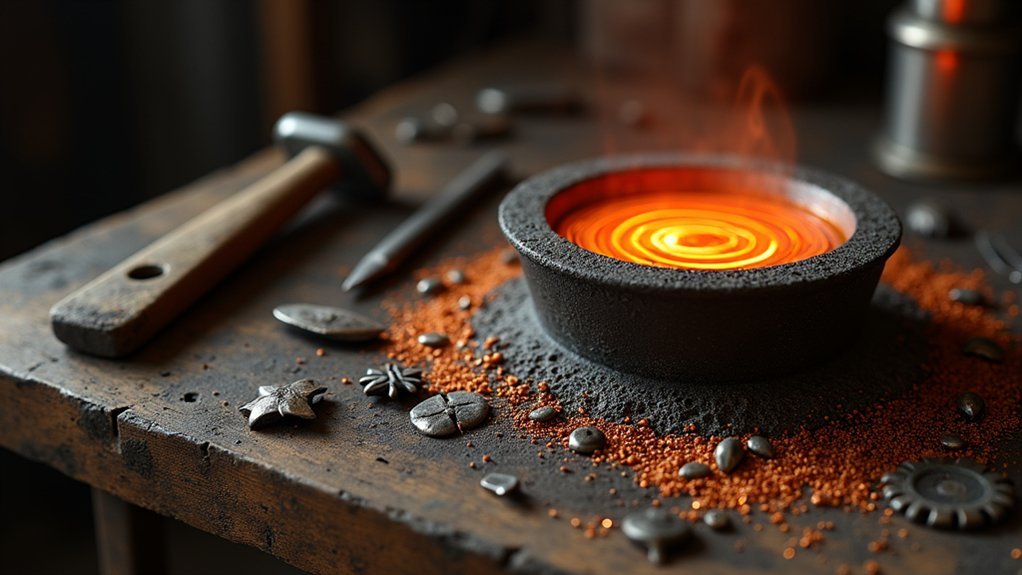
When you examine Roman metalworking techniques, you’ll discover that craftsmen primarily relied on lead-tin alloys for their soldering needs. The most effective composition contained approximately 60% lead and 40% tin, creating a low melting point that made joining metals straightforward and efficient.
You’ll find that these lead-tin alloys served dual purposes in Roman society. They worked excellently for soft soldering applications and proved essential in plumbing systems, particularly when connecting the extensive lead piping networks throughout the empire.
The combination’s low cost and ease of use made it accessible to craftsmen across various social levels.
Roman metalworkers enhanced their soldering process by incorporating flux materials like borax, which improved bonding between metals and guaranteed stronger, more durable connections in their sophisticated metalwork.
Bronze Valve Construction and Soldering Methods
Roman engineers applied their sophisticated lead-tin soldering techniques to create some of the empire’s most impressive bronze valves.
You’ll find these valves were constructed from bronze with a precise composition of 73% copper, 19% lead, and 8% tin—standards comparable to modern materials. The engineers used molten lead solder exclusively, avoiding threaded joints entirely in their assembly process.
Roman engineers achieved remarkable precision with their 73% copper, 19% lead, 8% tin bronze composition, using exclusively molten lead soldering techniques.
You’d be impressed by their cylindrical chamber design, which housed rotating plugs for water flow control.
Roman craftsmen employed heating methods alongside flux materials like natron and borax to achieve perfect bronze joints. Their advanced soldering skills produced remarkably durable valves capable of withstanding pressures up to 18 atmospheres in water distribution systems throughout the empire.
Heat Sources and Temperature Control Techniques
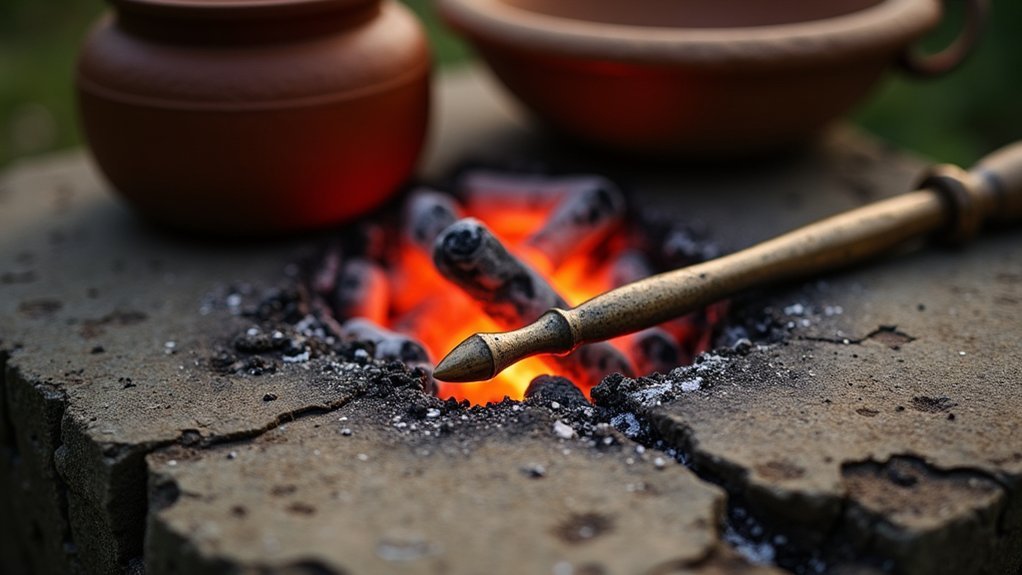
You’ll find that Roman metalworkers relied on open fire methods as their primary heat source for soldering operations.
They’d combine charcoal with bellows to achieve the intense temperatures needed for effective metal joining.
These bronze forge techniques allowed craftsmen to maintain precise control over heat distribution during complex soldering tasks.
Open Fire Methods
Several heat sources formed the backbone of Roman soldering operations, with open fire methods proving most practical for metalworkers of the era. You’d find craftsmen building charcoal fires and using bellows to achieve temperatures necessary for melting various solders. These techniques evolved from bronze age practices, becoming more sophisticated over time.
| Heat Source | Temperature Control | Application |
|---|---|---|
| Charcoal fires | Bellows adjustment | General metalwork |
| Blowpipe technique | Directed flame | Precision joints |
| Alcohol lamps | Tube directing | Practice/training |
| Charcoal blocks | Heat reservoir | Temperature stability |
| Combined methods | Multiple controls | Complex projects |
You’d control temperatures by adjusting airflow through bellows or positioning your workpiece closer to or farther from the flame. Different solder materials required specific heat levels, making temperature management vital for successful bonding without damaging delicate components.
Charcoal and Bellows
Among these open fire approaches, charcoal fires became the cornerstone of Roman soldering workshops.
You’d find artisans using charcoal as their primary heat source because it produced the high temperatures needed to melt soldering materials effectively. They’d employ small bellows to increase airflow, intensifying the fire and giving them better control over heat application.
This charcoal and bellows combination created concentrated heat that let you work with both soft and hard solders.
You could control temperature by adjusting your metal’s distance from the fire or using a blowpipe to direct air precisely onto the soldering area. This setup allowed Roman craftsmen to join various metals across different applications, making it an essential technique in their metalworking arsenal.
Bronze Forge Techniques
When working with bronze specifically, Roman craftsmen developed sophisticated forge techniques that went beyond basic charcoal fires.
You’d find them using specialized forges designed to maintain consistent temperatures needed for bronze work. These forges incorporated advanced bellows systems that provided steady airflow control, allowing craftsmen to regulate heat intensity precisely.
The Romans created primitive versions of what we’d recognize as a soldering iron by heating metal tools in these controlled forge environments.
They’d place bronze components directly in strategic flame positions to achieve ideal soldering temperatures. The sweating technique proved particularly effective with bronze, as the metal’s thermal properties allowed solder to flow smoothly between fitted joints.
This combination of controlled forge heating and direct flame application gave Roman metalworkers remarkable precision when joining bronze pieces.
Flux Materials Used by Roman Craftsmen
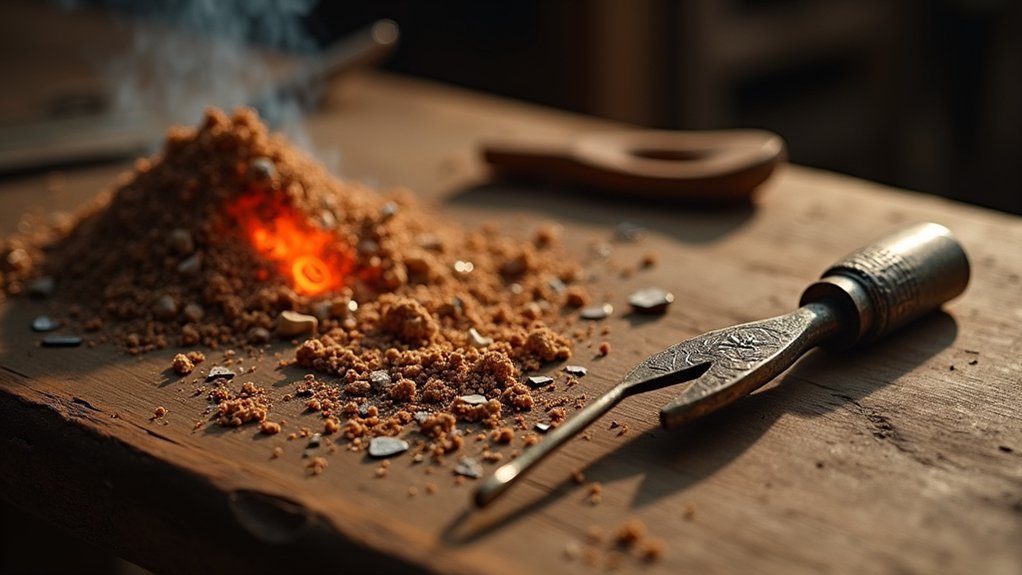
Roman metallurgists demonstrated remarkable ingenuity in their selection and application of flux materials, employing both organic and mineral substances to guarantee successful metal joining.
You’ll find their sophisticated approach involved understanding chemical interactions that enhanced bonding processes.
Their primary flux materials included:
- Organic substances – Mutton fat and tallow served as effective fluxes for soft solder applications, while wine lees provided an alternative organic option.
- Mineral compounds – Borax (sodium borate) was essential for silver solder work, creating superior bonds between precious metals.
- Natural salts – Natron and simple salt offered reliable flux properties for various soldering techniques.
Roman artisans also utilized copper salt combined with organic binders for specialized methods, showcasing their advanced metallurgical knowledge and adaptability in selecting appropriate materials.
Water Pipe Assembly and Lead Soldering
You’ll find that Roman craftsmen mastered molten lead welding techniques to create watertight seams in their extensive water distribution systems.
They’d heat lead solder to its melting point and apply it directly to pipe joints, forming durable connections that could withstand pressures up to 18 atmospheres.
When integrating bronze valves and fittings, they’d weld these components directly into the lead piping system rather than using threaded joints.
Molten Lead Welding Technique
The molten lead welding technique revolutionized Roman water pipe assembly, enabling engineers to create seamless joints that could withstand enormous pressure without modern threading systems.
You’d heat lead until it reached its melting point, then carefully apply the molten metal to pipe joints. This lead solder created incredibly strong seams that could handle up to 18 atmospheres of pressure.
The technique’s effectiveness stemmed from three key advantages:
- Low melting point – Lead melted easily, making application straightforward
- Superior adhesion – Molten lead bonded perfectly with existing pipe surfaces
- Leak-proof seals – The process eliminated gaps that could cause water loss
Without threaded connections, Romans relied entirely on this welding method to construct their extensive aqueduct networks and urban plumbing infrastructure.
Bronze Valve Integration Methods
When constructing complex water distribution networks, Roman engineers faced the challenge of integrating bronze valves directly into their lead pipe systems without compromising structural integrity.
You’d see them solve this by welding bronze valves straight into lead pipes using molten lead solder, completely eliminating threaded joints that could fail under pressure.
These bronze valves featured both inline and angle configurations, giving you precise control over water flow direction and volume.
The cylindrical chamber design allowed engineers to insert plugs for managing distribution and pressure throughout the system.
They’d standardize their valve composition at 73% copper, 19% lead, and 8% tin, ensuring excellent durability and corrosion resistance.
This integration method enabled Roman engineers to construct extensive networks spanning 400 kilometers while withstanding significant water pressure.
Standardized Compositions and Quality Control
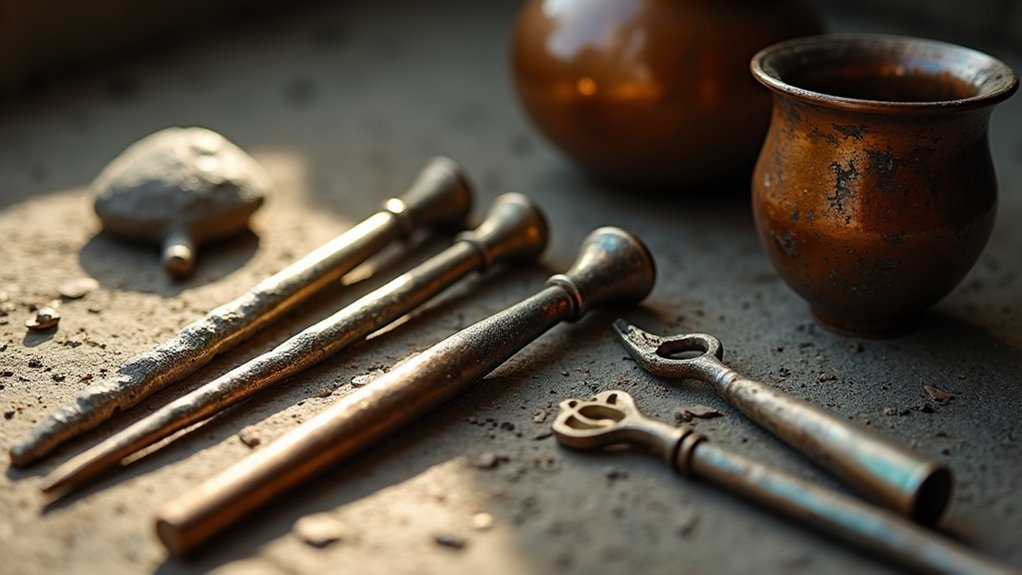
While Roman engineers faced the monumental task of supplying water to millions across their empire, they developed remarkably sophisticated quality control measures that rival modern manufacturing standards.
Their valve production utilized standardized bronze compositions that match today’s ASTM B67 specifications for journal bearings, demonstrating advanced metallurgical expertise.
Roman quality control encompassed three critical areas:
- Material Consistency – Valves contained precisely 73% copper, 19% lead, and 8% tin across the empire.
- Manufacturing Standards – Rigorous production processes guaranteed durability and reliability in water systems.
- Component Uniformity – Frontinus documented standardized pipe sizes and flow capacities for empire-wide compatibility.
This attention to corrosion resistance and ductility enabled their silver solder joints and plumbing systems to function effectively for centuries.
Tools and Equipment for Ancient Soldering
Flickering flames and glowing coals transformed Roman workshops into precision manufacturing centers where craftsmen wielded an arsenal of specialized tools to create their enduring water systems.
You’d find open fires as the primary heat source, with bellows pumping air to intensify flames for precise metal heating. Charcoal blocks acted as thermal reservoirs, maintaining consistent temperatures essential for effective joint formation.
Your blow pipe worked alongside alcohol lamps, giving you directional flame control and adjustable intensity for delicate work.
These tools enabled you to manipulate soft solders made from lead-tin alloys or stronger silver-based compositions. Flux materials like borax and mutton fat completed your toolkit, cleaning metal surfaces and ensuring superior bonding during the soldering process.
Archaeological Evidence From Pompeii and Beyond
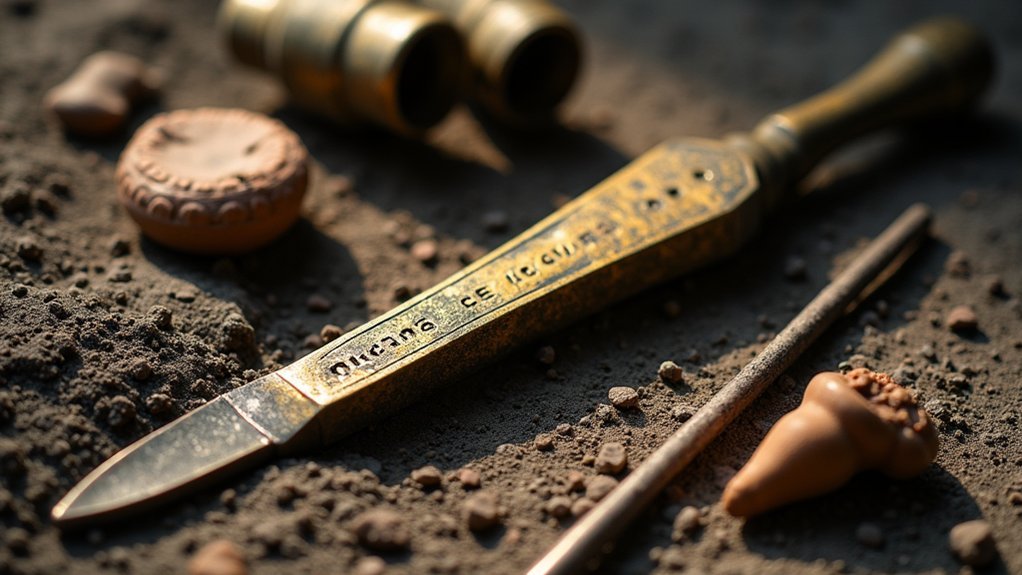
Beneath layers of volcanic ash, Pompeii’s preserved workshops reveal extraordinary evidence of Roman soldering mastery that surpassed many medieval techniques.
You’ll discover that Romans mastered lead soldering for complex water distribution systems, creating pipe manifolds with integrated valves that demonstrate remarkable engineering sophistication.
Archaeological excavations show three key soldering applications:
- Water pipe systems – Lead solder created seams withstanding up to 18 Atm pressure
- Bronze household items – Stoves and tubs made of bronze utilized advanced metal joining techniques
- Complex manifolds – Integrated valve systems showcased precision soldering skills
You can observe how Romans used molten lead for welding joints, revealing their deep understanding of material properties.
These findings highlight soldering’s central role in Roman engineering and daily life, proving their techniques were far more advanced than previously imagined.
Frequently Asked Questions
How Did Romans Solder Lead Pipes?
You’d heat lead until it became molten, then carefully pour it into joints between pipes. You’d control temperature precisely to avoid melting entire pipes while creating strong, seamless connections that withstood high pressures.
How Was Soldering Done Before Electricity?
You’d use open flames with blowpipes, charcoal fires with bellows, or alcohol lamps to heat metal pieces. You’d apply flux materials like mutton fat or borax to clean surfaces and improve the bond between metals.
What Techniques Were Used in Medieval Soldering?
You’d use spirit blow lamps for precise heat control and soldering irons with pyramidal heads. You’d apply flux like borax to prevent oxidation, then “sweat” molten solder onto joints while carefully controlling temperatures.
How Did Romans Melt Iron?
You’d use a bloomery furnace reaching 1,200-1,500°C with charcoal as fuel. You’d layer iron ore and charcoal, then hammer the resulting spongy bloom to consolidate the wrought iron and remove impurities.
In Summary
You’ll find that Roman soldering techniques were remarkably sophisticated for their time. They’d mastered lead-tin alloys, developed effective flux materials, and created standardized quality controls that’d rival modern practices. You can see their expertise in surviving water pipes, bronze valves, and artifacts from Pompeii. Their temperature control methods and specialized tools show you’re looking at craftsmen who’d perfected metallurgy through centuries of innovation and practical application.

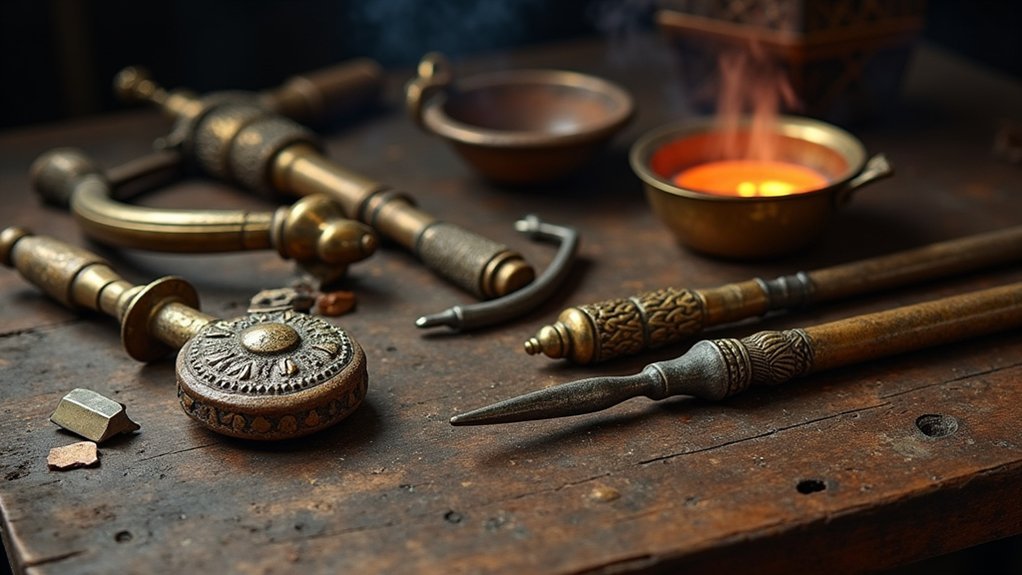
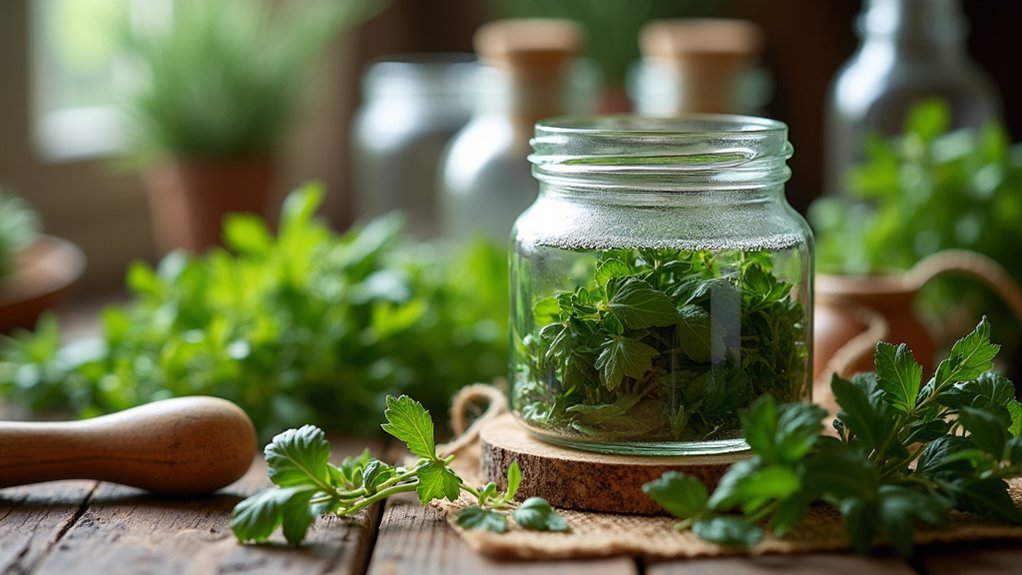
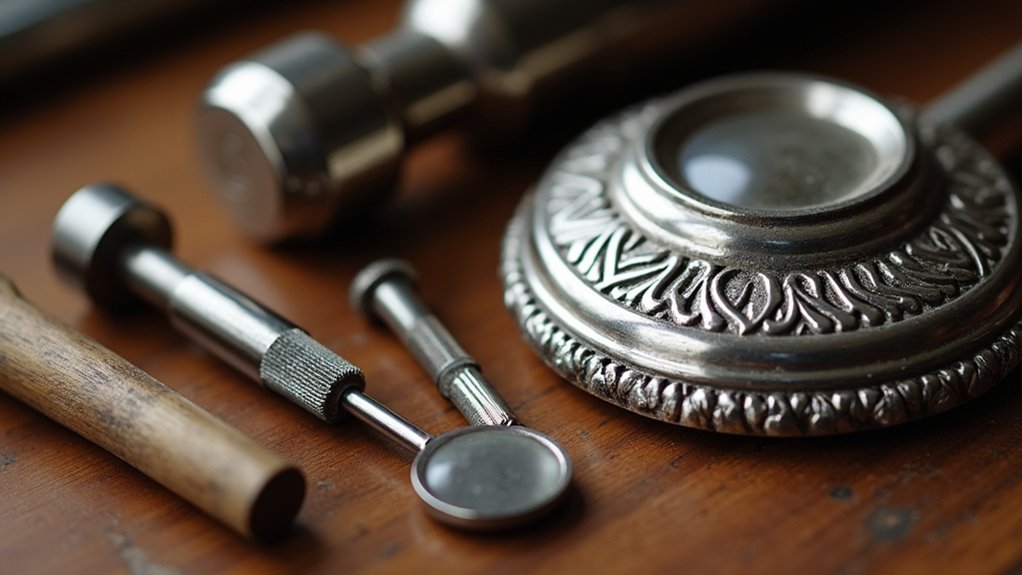
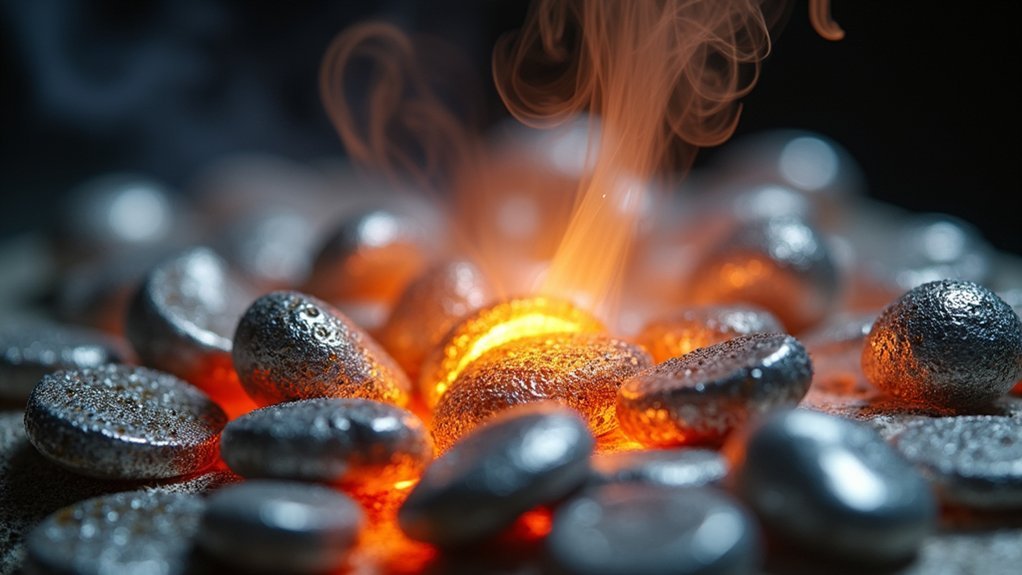
Leave a Reply